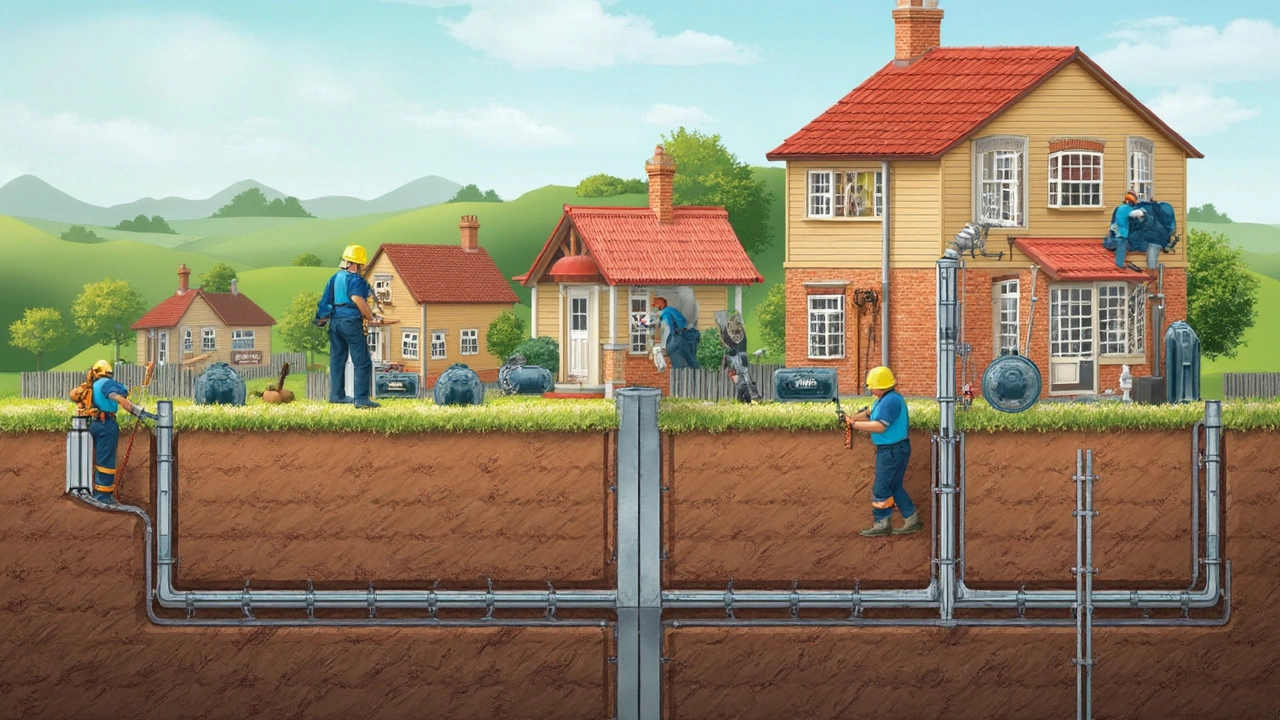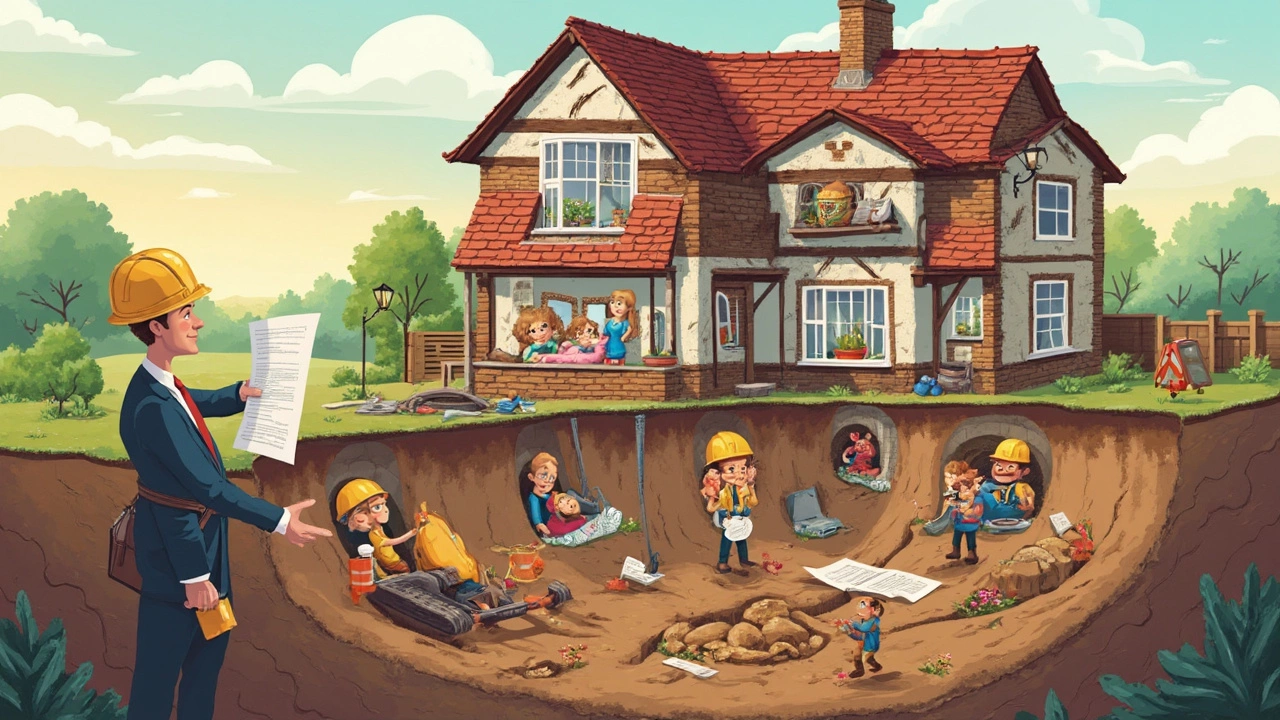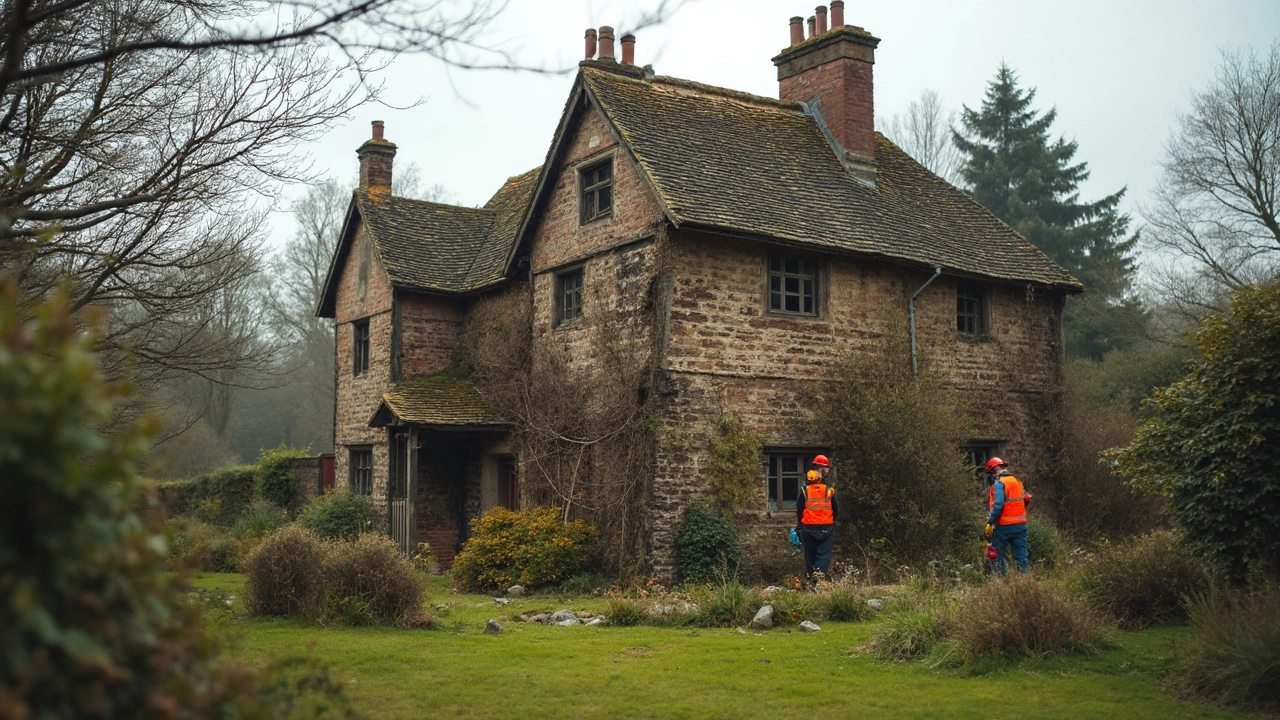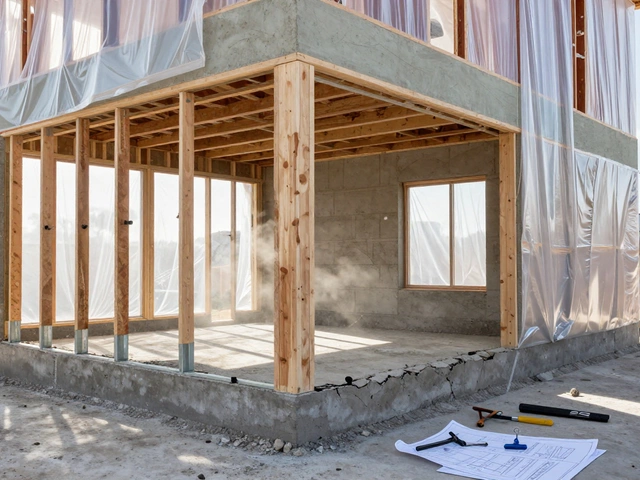So, ever glanced at that crack in your wall and thought, 'Hmm, that doesn't look right'? You’re not alone. Foundation issues are more common than you might think, and they have a sneaky way of popping up on domestic radar. But does fixing them actually make a difference, or is it just throwing money into a pit (quite literally)?
Let’s break it down. Foundation repair isn’t just a one-size-fits-all job. It involves different methods depending on what’s going wrong beneath your feet. Have you ever noticed doors that won’t close properly or floors feeling a bit like a funhouse ride? These are signs screaming at you that something's up with the foundation.
There are popular techniques out there that can set you right. Underpinning? It’s not just a fancy word; it’s actually a key strategy in lifting and stabilizing homes. Then there’s mudjacking—which might sound like a messy weekend project but is actually a pretty effective method of leveling concrete.
Wondering if it's worth calling in the pros? Consider it anytime you see new or growing damage. Attempting a DIY with your home's foundation might save a buck or two in the short term, but long term? It’s a gamble that can cost more than just peace of mind.
- Understanding Foundation Issues
- Methods of Repair
- Common Misconceptions
- Signs You Need Repair
- When to Call a Professional
Understanding Foundation Issues
You know how they say a house is only as strong as its foundation? It's true, and here's the lowdown on what can go wrong. When your foundation starts to fail, it’s not just about aesthetics—it’s a structural wake-up call. But before you start panicking, let's understand the why and how.
Why Foundations Fail
The soil under your home is like the foundation's backbone, and some soils are like rebellious teenagers—they don't always do what you expect. Changes in moisture levels can cause soil to expand or contract, wreaking havoc on your foundation. It’s kind of like when Finn, my kid, overacts when he doesn’t get his dessert—dramatic shifts that throw everything off balance.
Other culprits? Poor drainage around the house, plumbing leaks, or even tree roots getting all up in your business. Plus, if the foundation wasn’t built right to begin with, then you’re dealing with a shaky starting point.
Spotting the Red Flags
So, what does this all mean for you? Well, keeping an eye on signs is key. Look for these clues:
- Cracks in your walls, especially around windows and doors.
- Gaps forming above kitchen cabinetry or between walls and ceilings.
- Floors that are sloped or unlevel—no, it’s not an optical illusion.
- Doors and windows that stick or don’t latch properly—it's not just the humidity.
The Domino Effect
A foundation hiccup isn’t just a solitary issue. It's like a domino game—one small press can topple the whole setup. So, addressing these issues promptly can save you a world of headaches. For instance, that unfixable door could misshape walls or damage ceiling tiles. See a pattern here?
Need some numbers to chew on? Homeowners in the U.S. spend around $4,500 on average to fix these issues, though it can range based on what needs fixing. The longer you wait, the heftier the bill—kind of like procrastinating on getting homework done.
| Issue | Average Cost |
|---|---|
| Minor Cracks | $500 - $1,000 |
| Major Shifting or Sinking | $10,000+ |
Recognizing these issues upfront gives you the power to tackle them head-on. Ignore them, and let's just say the stakes, like your costs, only grow.
Methods of Repair
So, how do we actually go about fixing that shaky foundation? Let's dive into the nitty-gritty of foundation repair, where several methods come into play. Not all crumbling bases are created equal—they each demand their own approach.
Underpinning
This is where it all begins for many. Underpinning is all about providing extra support to an unstable foundation, kind of like giving it a helpful push from below. This method involves extending the foundation in depth or width so it can rest on more stable soil. It's often a go-to for homes sitting on loose or shifting grounds.
Mudjacking
Ever play in the mud as a kid? Imagine injecting a mix of mud and cement beneath your house to lift sagging concrete and fill voids below. That’s mudjacking for you. It’s especially useful for leveling concrete slabs and is cost-effective compared to some other techniques. Get rid of those awkward ramps in floors with a little help from this trusty method.
Slab Jacking
This is a close relative to mudjacking. The concept is similar—lift and stabilize sunken concrete—but uses high-density polyurethane foam instead of mud and cement. It’s perfect for patios, driveways, and walkways. Plus, it hardens super fast and doesn’t add much weight to the soil beneath.
Helical Piers
Tackling something a little more serious? Helical piers might be your answer. These are metal poles screwed into the ground to anchor your home to deeper, more stable soil layers. They're perfect for heavier homes or those with more pronounced settlement issues. Like when you're looking for that firm handshake in the ground!
Steel Push Piers
These are similar to helical piers but are hydraulically driven into the ground. Well, think of them as the bulldozers of foundation fixing. When the soil beneath is too stubborn and regular underpinning won't cut it, push piers come into the scene like foundation superheroes, giving support exactly where needed.
Understandably, each of these methods has its ups and downs (literally), and the suitability often depends on specific circumstances of the property. Consulting with a professional can provide clear guidance and help decide which repair job will have your house standing tall again.

Common Misconceptions
There's a truckload of myths about foundation repair floating around, some of which can scare homeowners senseless. So, let's set the record straight and debunk a few of the misunderstandings that might be preventing folks from taking action.
Misconception 1: Foundation Repair Is Just a Temporary Fix
This one gets a lot of airtime, but it's not accurate. Many believe that addressing issues beneath a home is like sticking a Band-Aid on a bigger problem—that eventually, they'll be back in the same boat. The truth? Done right, repairs can last for decades. According to the National Association of Home Builders, a well-executed repair provides permanent solutions that stand up to time and environmental pressures.
"With proper installation and ongoing maintenance, foundation repairs can offer long-term solutions to complex structural issues," says Michael Leavitt, a structural engineer with over two decades of experience.
Misconception 2: It's Always Way Too Expensive
When people hear 'foundation repair,' they often see ominous dollar signs. Sure, some repairs can be costly, but they're not universally bank-breaking. Plus, addressing problems early on can save big bucks down the line, potentially preventing more extensive (and expensive) work. For instance, dealing with minor cracking now could mean avoiding a total foundation overhaul later.
Misconception 3: Only Old Homes Need Repairs
While older homes might seem like obvious candidates for foundation work due to settling over time, young homes aren't off the hook. Newer properties face issues from natural events like earthquakes or floods too. So, don't snooze just because your house has a more recent build date.
It's smart to tackle these misconceptions head-on. Whether you're dealing with a decades-old structure or a shiny new home, knowing the truth about foundation repairs puts you one step ahead in maintaining your property’s structural integrity.
Signs You Need Repair
Wondering if your home is sending out distress signals? When it comes to foundation repair, catching the warning signs early can save you a ton of hassle (and cash) down the road. Here’s what to look for:
Creepy Cracks
Check out the walls and floors. If you’re seeing more cracks than usual, it might not just be the house settling. Vertical cracks mean different things than horizontal ones; especially in the foundation, they can indicate serious trouble.
Doors That Don’t
Ever opened a door and didn’t expect a workout? If your doors and windows are suddenly getting stuck or won’t fit right, it could be a foundation issue making things go wonky.
Slanted Floors
Feel like you’re walking uphill in your own home? Uneven or slanted floors are shouting for attention. It might be hard to spot but trust your gut (literally, if you feel off-balance).
Water Woes
Water is a sneaky culprit. Check for water pooling around the base of your house or signs of moisture in the basement. Even a little dampness can be a big indicator of foundation problems.
Gaps Galore
Notice any gaps in the ceiling and crown molding? Or maybe between the wall and floor? These gaps often mean movement in your house’s structure which needs fixing pronto.
While these signs are common indicators, not every crack or stuck door means your foundation is doomed. If you spot any of these warning lights, it's time to consider a call to the pros. They’ll assess if foundation repair is needed and help keep your home sturdy for the long haul.

When to Call a Professional
Not all foundation issues are DIY-friendly, even if you consider yourself a weekend warrior. Bringing in a professional can be crucial, especially when certain warning signs start to appear.
Obvious Damage
If you're spotting big, scary-looking cracks in your walls or foundation, it’s time to ring in the experts. These cracks aren’t just a cosmetic issue, they often mean that your home’s structure could be compromised.
Persistent Problems
Sometimes, those handy fixes just don’t stick. Doors still stick, or windows refuse to slide no matter how much force you use. Could it be a more serious underlying issue? You betcha, and a professional can confirm and correct it.
Unlevel Floors
When you feel like you're traversing hills in your living room, you've got a foundation issue that's likely beyond a DIY fix. Floors that are uneven are a classic sign that something’s up with your home's structural integrity.
Water Woes
Is your basement damp or flooded after just a sprinkle of rain? Water intrusion could indicate foundation damage or poor drainage, and with it can come a host of problems including mold. Experts can diagnose a drainage issue or a more serious threat to the foundation, saving you tons of hassle.
| Warning Sign | Potential Issue |
|---|---|
| Large Cracks | Structural Compromise |
| Unlevel Floors | Foundation Settling |
| Sticking Doors | Foundation Shifts |
| Water in Basement | Poor Drainage/Foundation Crack |
Getting a professional assessment can actually save money in the long run, preventing these small issues from snowballing into massive headaches. Remember, it's not just about repair; it's about preserving the longevity and safety of your home.
Know When to Step Back
It's all about knowing when to step back and let someone else do the heavy lifting, literally. If you notice any of these signs, don't hesitate to make that call.








